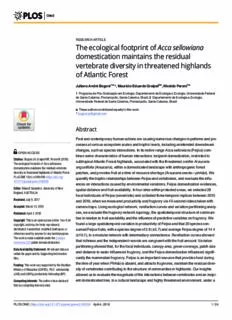
The ecological footprint of Acca sellowiana domestication maintains the residual vertebrate PDF
Preview The ecological footprint of Acca sellowiana domestication maintains the residual vertebrate
RESEARCHARTICLE The ecological footprint of Acca sellowiana domestication maintains the residual vertebrate diversity in threatened highlands of Atlantic Forest JulianoAndre´Bogoni1☯*,Maur´ıcioEduardoGraipel2☯,NivaldoPeroni1☯ 1 ProgramadePo´s-Graduac¸ãoemEcologia,DepartamentodeEcologiaeZoologia,UniversidadeFederal deSantaCatarina,Floriano´polis,SantaCatarina,Brazil,2 DepartamentodeEcologiaeZoologia, UniversidadeFederaldeSantaCatarina,Floriano´polis,SantaCatarina,Brazil a1111111111 ☯Theseauthorscontributedequallytothiswork. a1111111111 *[email protected] a1111111111 a1111111111 a1111111111 Abstract Pastandcontemporaryhumanactionsarecausingnumerouschangesinpatternsandpro- cessesatvariousecosystemscalesandtrophiclevels,includingunintendeddownstream changes,suchasspeciesinteractions.InitsnativerangeAccasellowiana(Feijoa)com- OPENACCESS binessomecharacteristicsofhumaninteractions:incipientdomestication,restrictedto Citation:BogoniJA,GraipelME,PeroniN(2018) subtropicalAtlanticForesthighlands,associatedwiththethreatenedconiferAraucaria TheecologicalfootprintofAccasellowiana angustifolia(Araucaria),withinadomesticatedlandscapewithanthropogenicforest domesticationmaintainstheresidualvertebrate diversityinthreatenedhighlandsofAtlanticForest. patches,andprovidesfruitatatimeofresourceshortage(Araucariaseeds—pinhão).We PLoSONE13(4):e0195199.https://doi.org/ quantifythetrophicrelationshipsbetweenFeijoaandvertebrates,andevaluatetheinflu- 10.1371/journal.pone.0195199 encesoninteractionscausedbyenvironmentalvariations,Feijoadomesticationevidences, Editor:ManuESaunders,UniversityofNew spatialdistanceandfruitavailability.Infoursiteswithinprotectedareas,weselected28 England,AUSTRALIA focalindividualsofFeijoa(seven/site)andcollectedthreetemporalreplicasbetween2015 Received:July9,2017 and2016,whenwemeasuredproductivityandfrugivoryvia45-secondvideostakenwith Accepted:March13,2018 cameratraps.Usingecologicalnetwork,rarefactioncurvesandvariationpartitioninganaly- ses,weevaluatethefrugivorynetworktopology,thespatiotemporalstructureofcommuni- Published:April4,2018 tiesinrelationtofruitavailabilityandtheinfluenceofpredictivevariablesonfrugivory.We Copyright:Thisisanopenaccessarticle,freeofall foundalargespatiotemporalvariationinproductivityofFeijoaandthat20speciescon- copyright,andmaybefreelyreproduced, distributed,transmitted,modified,builtupon,or sumedFeijoafruits,withaspeciesdegreeof2.8(±5.7)andaverageFeijoadegreeof14.4 otherwiseusedbyanyoneforanylawfulpurpose. (±10.1),inamodularnetworkwithintermediaryconnectance.Rarefactioncurvesshowed TheworkismadeavailableundertheCreative thatrichnessandtheindependentrecordsarecongruentwiththefruitamount.Variation CommonsCC0publicdomaindedication. partitioningshowedthat,forthefocalindividuals,canopyarea,greencoverage,patchsize DataAvailabilityStatement:Allrelevantdataare anddistancetowaterinfluencedfrugivory,andtheFeijoadomesticationinfluencedsignifi- withinthepaperanditsSupportingInformation files. cantlythemammalianfrugivory.Feijoaisanimportantresourcethatprovidesfoodduring thetimeofyearwhenPinhãoisabsent,andattractsfrugivores,maintaintheresidualdiver- Funding:ThisworkwassupportedbytheBrazilian MinistryofEducation(CAPES),Ph.D.scholarship sityofvertebratescontributingtothestructureofcommunitiesinhighlands.Ourinsights (JAB)and(CNPq)productivityfellowship(NP). allowedustoevaluatethemagnitudeoftheinteractionsbetweenvertebratesandanincipi- Competinginterests:Theauthorshavedeclared entdomesticatedtree,inaculturallandscapeandhighlythreatenedenvironment,undera thatnocompetinginterestsexist. PLOSONE|https://doi.org/10.1371/journal.pone.0195199 April4,2018 1/24 Feijoadomesticationmaintainstheresidualvertebratediversity basalfoodwebapproachwithimplicationsforbottom-upandtop-downforces.Theresults contributetounderstandinganimal-plantrelationships,includingconceptsthatcanberepli- catedforothersessilepreyandmobilepredatorsinanyregionorhabitatunderdifferentgra- dientsofmanagement.Thus,thisworkshowshowhumanactionscanchangenotonly patternsofdistributionandabundancebutalsothediversityanddirectionofinterspecific interactionsamongspecies. Introduction Ecologicalsystemsarecomplex,dynamic,self-organized,withemergentproperties,andfeed- backs[1].Inaddition,pastchangesandthepersistentfeedbacksgeneratedbyhumanecosys- temengineersincoconstructedlandscapeswithnaturehaveimportantimplicationsfor currentdiversitypatternsandecologicalprocesses[2–3].Yet,contemporaneousdisruptions canpromotenumerouschangesandmoveecosystemsfromonestablestatetoanotherstable alternative:aprocessknownasphaseshifts[4].Oneofthesedisordersis“Anthropocene Defaunation”:aprocessofextinctioncausedbyhumanimpacts[5–6].Themainhuman- drivencausesofdefaunationandcompositionalchangesarehabitatloss,fragmentation,hunt- ingandforestconversion[7–8].Compositionalchangesandselectivespecieslossincommu- nitiescanproducestrongside-effectimpactsonecosystemfunction,promotingcascade effectsatseveralscales[9].Theseeffectsincludeevolutionarychanges(e.g.,decreasingseed size)andaffectpopulationdynamicsandcommunitystructure(e.g.,changesinthedetritivore foodweb,seeddispersalandtrophicwebs,andrearrangementsoftop-downandbottom-up forces)[9–11]. Thetop-downmodelofcommunityregulationpredictsthatorganismscanbelimiting resources,bothaspredatororprey,dependingontheirpositioninthefoodweb[12].The effectivenessoftop-downvs.bottom-upforcesinthechaindependsinpartonhowmanyeffi- cientconsumersexploittheirprey[12].Thechaindynamicmodelsoffoodwebsareoften unpredictablebecausedifferentassumptionsaboutmechanisms(e.g.,co-limitationbypreda- torsandresources)leadtodifferentpredictions(e.g.,consumerefficiencyatamulti-trophic level)[13].Amongvariousprocessesthatfitthesepremises,frugivoryisanidealcandidatefor theseecologicalandevolutionaryanalyses[14–16].Patternsandprocessesofpredation/dis- persalofseedsarehighlystructuredandcoevolvedspatiotemporally[14],withpotentialalter- ationspromotedbothbypasthumandrivers[2]andcurrentdisturbances[9].Plant-animal interactionswithinacommunityshouldconsidertheenergyusedattheindividuallevel[14, 17]. Mammalsandbirdsdisperseabout90%ofthewoodyplantspeciesthatproducefruitsin Neotropicalenvironments,generatinganimportantfeedbacktoplantfitnessandforestregen- eration[15,18].IntheAtlanticForestofSouthAmerica,thefamilyMyrtaceaeisanimportant groupofwoodyspeciesandresourceproviderforarangeofvertebratetaxa[19–20].Myrta- ceaespeciesarethemaincomponentsofloweraltituderainforests,wheretherecanbeover 50speciesinarelativelysmallspace(~1ha)[21–22].InsubtropicalAtlanticForest,Myrtaceae ingeneralarecloselyassociatedwiththethreatenedconiferAraucariaangustifolia(Araucaria), whichformOmbrophilousMixedForest(FOM)[23].ForestsdominatedbyAraucarias havebeenusedasaproxyforconservationstrategies[24].WithinFOMthereisavegetation mosaicofhighlands(e.g.,uppermontaneforest,swamps,andnativegrassland)thatisspatially restrictedandhighlyendangeredmainlyduetoclimatechange[24–26].Ininterspersedforest PLOSONE|https://doi.org/10.1371/journal.pone.0195199 April4,2018 2/24 Feijoadomesticationmaintainstheresidualvertebratediversity patchesinthismosaic,Araucariasdominatetheupperstratum,whileMyrtaceaeandLaura- ceaearethemainfamiliesthatformthemiddleandlowerstrata[27–28]. AfewMyrtaceaespeciesdominatetheflorainhighlands,whichareusuallycharacterized bysmallfruits(<1cmofdiameter)[29–30].AnexceptiontothisisAccasellowiana(Berg) Burret(Feijoa).FeijoaisatreenativetoSouthernBrazilandnorthernUruguaythatis restrictedtoareasinSouthernBrazilover800metersabovesealevel(m.a.s.l.)associatedwith FOM[23,31].Feijoaispollinatedbybirdsandbees[32–33],andproduceslargefruits(20to 250g)withsmallseeds(~3mm)[29].LikeAraucariainlocallandscapes,Feijoahasbeensub- jectedtohistoricalanthropogenicinfluencepromotingacertainlevelofdomesticationof somepopulationsinsitu,whichhasresultedinincreasedfruitsizeandproductivitybyhuman selection[23,34–36].Currently,withinFOM,Feijoaisusedinseveralways(circa14)bylocal peoplethatmanagethespeciesviapruning,transplanting,propagationbyseedsandvegetative propagation[23].Itsdomesticationisincipient[23],aprocessthatexhibitsphenotypicvaria- tionwithintherangenormallyfoundinwildpopulations[37–39].Moreover,theexpansionof FOMbypre-Columbianpeople(i.e.,indigenousXoklengandKaingang)favoredtheexpan- sionofFeijoaandotherassociatedMyrtaceae[23,35].Inaddition,thepastandcontempora- neousmanagementofFeijoaandAraucariaincreasedtheavailabilityofresourcesinFOM [23,35]. Plantandanimaldomesticationisthemostimportantdevelopmentofhumanhistorysince 13,000yearsago,andchangedthecourseofhumanity[40].SinceDarwin(1859),domesticated systemshaveplayedacriticalroleinthedevelopmentandtestingofevolutionarytheory[41]. Managementofnativefruitsinsitu,bothbyindigenouspopulationsandlocalfarmers,isa recognizedconservationpracticethatcontributestogeneticdiversityandseveralecological processesthroughdownstreampropagationwithinbiologicalnetworks[42–45].Anotherout- standingcharacteristicoflocallandscapedomestication—humaninterventionintheland- scapecomponentsresultinginchangesinevolution,ecology,interactionsandspecies demography[3,37]—isthepresenceofBostaurus(cattle)anditsimpacts[36].Cattleisan allochthoneelementthathasbeenmanagedforalongtime(>100years)bylocalsmall-scale landownersinhighlandsofsubtropicalAtlanticForest[36].Understandingthecomplexeco- logicallegacyofmanagementinpastlandscapesandtheirusecomponentsisimportantwhen debatesareragingaboutthefutureofforestsinrelationtonewhumancolonizationdynamics, climatechange,contemporaneouspoliticalconflictanddefaunation[2,46]. Currently,primarydispersionofFeijoaisbarochoric[47],becausethedistributionregion ofFeijoaoverlapareasunderaconstantdefaunationoflarge-bodiedvertebrates[8],remaining onlyaresidualdiversityreducedtoapaleshadowoftheonceamazingbiotaoftheAtlantic Forest.Yet,Feijoastillhasaposthocassociationwithfrugivores[29].Thefunctionallossof largefruit-eatingvertebratescandecreaseFeijoafitnessnearconspecificadults[16,48],dis- ruptsthenaturalregenerationdynamicsofplants,andchangesthemaincomponentsofthe dispersalprocess[16,49].ThereislittleempiricalinformationontheinteractionofFeijoa withitsassociatedfauna,althoughtheremaybemanyspeciesthatfeedonitsfruits,asfound forotherMyrtaceaespecies,resultinginfeedbackthathelpsmaintainecosystemprocesses [13]. Therefore,asatemporaryalternativeduringtheaustralsummer-autumnwithscarce resources(mainlytheabsenceofpinhão),Feijoacanactasanattractor,contributingtothe structureofanimalcommunitiesandcanmaintaintheresidualdiversityofvertebratesin SouthernBrazilhighlands.Theaimofthisstudywastoprovideascenarioofthetrophicrela- tionsbetweenFeijoa(aspeciesunderincipientdomesticationandanalternativeresourcein threatenedhighlands)andlocalwildlife(whichhasexperienceddefaunationeffectsinaland- scapeinfluencedbyhistoricalmanagement),toevaluatethespace-timecongruencebetween PLOSONE|https://doi.org/10.1371/journal.pone.0195199 April4,2018 3/24 Feijoadomesticationmaintainstheresidualvertebratediversity diversitypatternsandresourceproductivity.Additionally,weaimedtoevaluatetheinfluence oftheenvironment,thespatialdistanceamongsites,theFeijoadomesticationevidence,and theresourceofferontheintensityoffrugivory.Weposedthreehypotheses:(1)mammalsand birdsthatremovefruitsofAccasellowiana–assumingaprioridefaunatedsites—aresmall-to medium-bodiedfrugivores-herbivore-omnivoresandthecattle;(2)theseasonalFeijoafruit structuresthevertebratefaunainspaceandtime,increasingthediversitypatternsincongru- encewithfruitoffer.Theproductivityislinkedwiththeincipientdomesticationprocess,and thepositiveeffectoffruitofferincludespeciesthatdonoteatfruits,animplicationofbottom- upcontrolwithhistoricalinfluences;and(3)thenumberofinteractionsarerelatedtoenviron- mentalpatterns,spatialdistances,Feijoadomesticationevidenceandresourceproductivity. Boththisfactorsdirectlyorindirectlyreflectslocallandscapedomesticationasawhole. Materialandmethods Ethicsstatement Datacollectionwasauthorizedbasedonlicensenumber47255fromInstitutoChicoMendes deConservac¸ãodaBiodiversidade(ICMBio).Withinprivateland(ReservaParticulardoPatri- moˆnioNatural(RPPNs))weconfirmthattheownerofthelandgavepermissiontoconduct thestudyonthissite.Weconfirmthatthefieldstudiesdidnotinvolvemanipulationofendan- geredorprotectedspecies,onlyspeciesrecordsviacamera-trap.Vertebraterecordswereper- formedwithnon-invasivesampling(i.e.camera-trap).Theworkwasnotsubmittedtoan InstitutionalAnimalCareandUseCommittee(IACUC)orequivalentanimalethicscommit- tee,becausethedatawerecollectedonlywithcamera-trap.Samplingproceduresand/orexper- imentalmanipulationswerereviewedorspecificallyapprovedaspartofobtainingthefield permitbythelicensenumber47255fromInstitutoChicoMendesdeConservac¸ãodaBiodi- versidade(ICMBio). Researchareasanddesign WeselectedfoursitesinprotectedareasofsubtropicalAtlanticForesthighlands,insouthern Brazil:withinSãoJoaquimNationalPark(S1andS2),surroundingsofRPPNGrandeFloresta dasArauca´rias(S3),andwithinRPPNLeãodaMontanha(S4)(Fig1;S1Table).Allareasfall withinthehumidsubtropics(Cfa:Ko¨ppen-Geigerclassification)[50],andareunequalinage andtermsofprotection,butsharesimilaritiesinmanagementandhistoricalexploitation[36, 51].Sitesliewithinaradiusofcirca40kmand—basedonpreviousstudiesandunpublished data—hasasimilarcompositionandrichnessoffauna,includingdefaunationindexes,and presumablyasimilarbiotaatpre-Columbianera[6;Bogonietal.unpublisheddata].Theareas featureelementsofculturallandscapes,whichincludeanthropogenicforestswithdifferent intensitiesofpastandpresentuse[35–36]andregenerationstages,formedbyAraucariaForest (FOM),cloudforest,andnativegrassland[52].Theseareasrepresentamosaicofforest patchesandhigh-altitudegrasslandcomposedbyoldruralproprietiesdestinedforcattle breeding,loggingandPinhãoextraction.Theseoldproprietieswereabandonedformorethan 10years,andarecharacterizedforthepresenceofrockstructurestoretainthecattle(taipas), thefoundationofold-houses(taperas),andotherstructureslinkedtopastlivestockactivities. AnexceptionisinS3thatremainwithintensivelivestockactivity.Moreover,inthesitesS1,S2 andS4havethepresenceofFeijoatreestypicallymaintainedwithmanagement(e.g.,tracesof pruning,producinglargestfruitsandlocatedneartooldproprietiesfoundations)[23,37]. Thesechangesinspeciestraitsstartingfromwildancestors(e.g.,changesonthemorphology ofaerialvegetativepartsandselectionoffruitssizeandquality)areclassicalsyndromesof domesticationinfoodcrops[53]. PLOSONE|https://doi.org/10.1371/journal.pone.0195199 April4,2018 4/24 Feijoadomesticationmaintainstheresidualvertebratediversity Fig1.Researchareas(politicalsizedotted),sitesandsampledesigntoevaluatetheremovalofAccasellowianafruit byvertebratefauna(mammalsandbirds)inhighlandsofsubtropicalAtlanticForest,Brazil.Inblack:polygonofthe site(basedonlowlandareaorfragmentsize);ingray:theremnantofAtlanticForestinyears2008–2010;linesinblack: rivers.S1andS2:SãoJoaquimNationalPark;S3:surroundingofRPPNGrandeFlorestadasArauca´rias;andS4:RPPN LeãodaMontanha. https://doi.org/10.1371/journal.pone.0195199.g001 PLOSONE|https://doi.org/10.1371/journal.pone.0195199 April4,2018 5/24 Feijoadomesticationmaintainstheresidualvertebratediversity Ateachsite,duetothesupplyofequipment,wechosesevenfocalindividualsofFeijoa basedonfruitpresenceand,asasecondaryfactor,thedistanceamongthemlargerthan150 m.Foreachfocalindividual,werecordedthefaunainthelowerstratum(~30cmfromthe ground)usingacameratrap(Bushnell:TrophyCamHD,Model:119537c,BushnellOutdoor ProductsCanada,Ontario,Canada),includingthreetemporalreplicasduring2015–2016 (autumninthebeginningof2015(TR1),middleofspringof2015(withoutfruits:TR2)and autumninthebeginningof2016(TR3)).Forthefocalindividuals1,4and7ofeachsite,we installedcameratrapsat(cid:21)1.7mhigh(upperstratum)andattachedfivefruitsoneachtree withnails.Sinceistechnicallyimpossibleattachfruitinlocationsthattheywouldoccurnatu- rally(e.g.,tipsofbranches),Feijoafruitswereattachedinatrunkcapableofreceivingthe smallnails(12x12mm)andthatitwaspossibletoinstallthecameratrapimmediatelyahead oftheseattachedfruits.Duetothenumberofavailablecameratraps,inTR2andTR3weonly usedonecameratrapintheupperstratumthatwasinstalledonfocalindividualone.This reductionincameratrapswithinupperstratumwaschosenbecauseaccordingtotheTR1the mainfrugivoryactivitywasperformedonlowerstratum.Thus,wecankeeptheequalnumber offocalindividual(seven)ineachtemporalreplica. Weleftthecameratrapsactiveineachsiteforatleast30daysorfor60daysinsiteswhere availablefruitsexceeded30days;inthesecases,after30daysweinspectedtheequipment. Thus,atotalof40(or32)cameratrapswereused,programmedtorecordfootagefor45sec- onds,withanintervalof45secondsbetweenrecordings,totaling4,470traps/day(Fig1).In bothstrataandtemporalreplica,weanalyzedtheindependenceofinteractionsaccordingto fruitsconsumed,withsequentialvideosofthesamespecies,whereconsumingthesamefruit wasconsideredasingleinteractionrecord.Weestablishedthespectrumoffruitremovalby thefollowingcriteria:(1)sinzoochory,thequantityofwholefruitstakenandtransportedaway fromthelocation;and(2)endozoochory,fruitsconsumedlocally[47].Additionally,we countedfruitremovalbysmallanimalsateachfocalindividualinTR1,using3-inchpipes stucktotheground,whichcontained5Feijoafruits(prohibitingtheaccessofmediumtolarge animals)(Fig1). Resourceavailability,environmentalandspatialdata Foreachtemporalreplicawithfruits(TR1andTR3),atthetimeofcameratrapinstallation (t0),wecountedthenumberoffruitsavailableonthegroundbelowthecanopyofthefocal individual.Weestimatedtheproductivityofeverytreebythenumberfruitsonthemain branch(orentiretreewhenpossible)multipliedbythenumberofequal-sizedbranchesonthe focalindividual(modifiedfromClarketal.2005)[54].Atintervalsof30days(t1)and60days (t2),wereturnedtocounttheamountoffruitonthetreeandquantifiedfruitavailabilitydur- ingcameratrapping.Int0,t1andt2,weweighedfivefruitsfromeachindividualwithaman- ualprecisionbalance,andcalculatedthebiomassforeachtime.Furthermore,inTR1we:(1) calculatedthefruitdecompositiontimeusing20fruitschosenrandomlyatasinglemoment, leftunderconditionssimilartothesites;and(2)countedthenumberofseedsin15fruits. Inthefirstyearofthestudy,werecordedthefocal-individualcanopyareaandthedistance ofthefocalindividualtotheclosestFeijoaadult(withreproductivesignalsorcircumferenceat breastheight(CBH)(cid:21)15cm)[55].Tocharacterizethesitehabitats,wemeasuredenviron- mentalfeaturesusinganadaptedpointquadrant(S1Fig)method[56].Foreachfocalindivid- ual,wemeasuredthecanopycoverpercentage(fromphotographstaken1.5mabovethe ground,atfourpoints(N,S,EandW)fivemetersfromeachindividual),diameter,heightand distancetothenearesttreeandshrub.Wealsoestimatedthepercentageofgroundcover(lit- terfallandherbaceousgreencoverwithin1m2delimitedontheground),slope,orientation, PLOSONE|https://doi.org/10.1371/journal.pone.0195199 April4,2018 6/24 Feijoadomesticationmaintainstheresidualvertebratediversity intensityofuseoftheareabylivestock(ordinal:0(absence)to4(high))andactualhuman presence(binary:0(low)and1(moderate)). WealsonotedthepresenceofevidencesofmanagementinthefocalindividualsofFeijoa (e.g.,tracesofpruning,treeandfruitsize,fruitvariety(e.g.,thinbark,moreappreciatedfor localpeopleconsumes)andproximityofplaceswithpasthumanactivities),thatcanindicate thecontinuityofdomesticationprocess[23,37,53](S1Fig).Wesupportedthisaforemen- tionedinformationwithsemi-structuredquestionaries’appliedtolocalpeople[Bogonietal. unpublisheddata].Thus,weobtainedaproportionofdomesticatedFeijoaswithinsitesbased onqualitativedata.Forthis,weconsideredpresenceFeijoaswithmanagementevidence (domesticatedFeijoas)andabsentforindividualsofFeijoa(“under-domesticated”Feijoas) withinconspicuousdomesticationevidence,althoughitmaypresentatalowerlevel(e.g., molecular))[37,53]. Moreover,wedelimitedoneplotof1,600m2ineachsitetodeterminethedemographic characteristics(accountofadults)ofFeijoawithinthesites(c).Wemeasuredlandscapechar- acteristicsofthesitesandthedistancebetweenfocalindividualsandsitesthroughgeorefer- enceddata.UsingGPS,satelliteimagesandQGissoftware[57],wemeasuredthelinear distancefromthefocalindividualtotheclosestwatercourse,tothenearestopenareaandto thenearestfragmentofnativeforest[58].Additionally,weobtainedthesize(asapolygon)of theforestfragmentorlowland(i.e.,várzeaorflatareasofriverbanks,anenvironmentwhere Feijoaoftenoccurs)basedoninsitupersonalobservationsandSantosetal.(2009)[23]. Dataanalysis Weperformedaprincipalcomponentanalysis(PCA)ofcorrelationtoevaluatetheordination samplingsitesacrossenvironmentalandlandscapeparameters,includingtheproportionof managedFeijoatreeswithinsites[59–60].Descriptively,weexploredthespatialdistance, demography,andfruitproductivityofFeijoaspersiteandtemporalreplicates(TR1andTR3), usingcentraltendencyandvariationmeasures.Weanalyzedthestructureofthecommunities usingdiversitydescriptors(i.e.,speciesrichnessandrarefactioncurveswithconfidenceinter- valsof95%foreachreplica)[61–62].Foreachsite,weonlyusedindependentvideorecord- ings,excludingrecordsofthesamespeciesatthesamefocalindividualfortimeintervals shorterthan1hour[63],adjustedbysitesamplingeffort,andassumingspatialdependence amongfocalindividualsformammalsandbirds. Weanalyzedthetopologyofweightedtwo-modefrugivorynetworkspersiteforeachtem- poralreplicateandperfocalindividual[64–65],inwhichasetofnodesrepresentingfrugivores speciesisconnectedtoanothersetofnodesrepresentingsamplingsitesorfocalindividual wheretheywererecordedconsumingFeijoafruits.Wecalculatedonequantitativemetric: (a)modularity,andthreequalitative(binary)metrics:(b)averagedegree(c)connectanceand (d)nestedness[66–67].Degreeisthenumberofinteractionseachnodehas.Modularity(M) quantifiesthetendencyofthenodestoclusterintocohesivegroupsthataremoreconnected amongthemselvesthanwiththerestofthenetwork[66].Connectanceistheproportionof realizedlinks,thatistheratiobetweenthenumberofinteractionsobservedinrelationtothe possibleinteractions[67].Nestedness(N)measuresthedegreebywhichthenestednetwork, showingapossiblehierarchicalpattern[68].Incaseofnestedness,oneormoresitescanbea subsetofothersiteswithlargestspeciesrichnessorlargestinteractionnumber.Formodular- ity,weusedNewman’smetric[64]andcompareditsempiricalvaluewithabenchmark distributionofmodularityvaluescalculatedtoanensembleof1000theoreticalmatricescre- atedbyanullmodel,inwhichspeciesdegreerangesbetweenzeroandthemeanofthedegree oftherealnetwork.Significance(p(cid:20)0.05)wasbasedontheratioatwhichlargerorequalto PLOSONE|https://doi.org/10.1371/journal.pone.0195199 April4,2018 7/24 Feijoadomesticationmaintainstheresidualvertebratediversity theobservedMvalueoccurredinthenullmodel[69].Fornestedness,weusedtheNODFmet- ric[68].NODFrangesfromzero,whenthematrixisperfectlynon-nested,to100,whenthe matrixisperfectlynested[70].WealsocomparedtheNODFvalueofempiricalnetworkwith abenchmarkdistributiongeneratedby1000theoreticalmatricesgeneratedbyanullmodel basedonaprobabilitymatrix(nullmodel2ofBascompteetal.2003)[69]andadoptingthe sameaforementionedcriterionforMsignificance[69].Additionally,toshowresourcesharing graphically,webuildthenetworkwiththedeconstructedinteractionspertemporalreplicain: (1)dispersergroups(mammalsandbirds);(2)dispersalsyndromes(endozoochoryandsin- zoochory);(3)verticalstrata(upperandlower);(4)time(t0tot1andt1tot2);and(5)circa- diancondition(dayandnight). Weperformedavariationpartitioninganalysistoassesstheenvironmental(includingFei- joadomesticationevidence),spatialdistanceandproductivityvariationeffectsoninteractions [59–60]atthefocalindividualscale,consideringthetwogroups(nativemammalsandbirds) separated.However,apriori,weconductedaprincipalcomponentanalysisofneighboring arrays(PCNM)todeterminesignificantspatialcomponentsobtainedbythearrayofdistance betweenfocalindividuals.ThePCNMsrepresentthespatialrelationshipbetweensampling sitesandcanbeusedaspredictorsofvariation.OnlypositivePCNMswereselectedaccording tospatialautocorrelationobtainedbyMoran’sindex[59–60]. Topartitionthevariation,weusedtheforwardselectionmethod(toreducethelikelihood ofatypeIerror)[71]toselectasubsetofsignificantpredictorvariablesbasedonthenon-mul- ticollineardata(testedaprioriviathevarianceinflationfactors)[72].Variationpartitioning performsRDAsforallpredictors,andindividuallyforeachsetofpredictors,removingeffects ofotherpredictors(e.g.,RDAfortheenvironmentremoveseffectsofspatialdistance).The proportionsexplainedbypredictorswererepresentedbyEzekiel-adjustedR2[73].Forthevar- iationpartitioning,wecorrectedtheasymmetryintheinteractionnumberusingHellinger transformation.Theasymmetryoftheenvironmentandlandscapefeatures(numericalmagni- tudes)wastransformedbystandardization,andtheresourceavailability(totalbiomass)was logarithmized[60].Webasedthesignificanceofvariationpartitioningtests(p(cid:20)0.05)on999 permutations.Forotheranalyses,usedtheoriginal,untransformeddatasets.Weperformedall analysesinR[74]withthesna[75],bipartite[76],vegan[77]andPackfor[78]packages. Results Environment,spatialdistancesanddemographicfeatures Environmentandlandscapefeatures,analyzedviaPCA,explained85.4%oftotaldatavariation amongsites,with52.7%oftheexplanationrelatedtoaxisone(linkedmainlytoslopeandlow- land/fragmentsize)and32.7%ofexplanationrelatedtoaxistwo(linkedtotreeheightanddis- tancetonearestfragment).Thesitesaredistinctinthefollowingaspects:S1isthefurthest fromawatercourse(340m);S2hashigheradultdensity(eachoneby5.5mapart);S3,besides theintensepresenceofcattle,ischaracterizedbythegreaterarea(697ha)of“várzea”;andS4 isthefurthestfromanopenarea(105m)(S2Fig).Althoughnotthemainfactorintheordina- tionanalysis,atdifferentintensitiesorreplications,therewasarealorvirtualpresenceofcattle inallsites.Theaveragedistancebetweensitesis23.7km(±11.3;1.6to34.3km).Thedistance amongfocalindividualsis261.5m(±182.4;11.3to496.5m)inS1,446.7m(±320.9;11.2to 1000m)inS2,346.4m(±246.7;7.7to716m)inS3,and584.9m(±356.4;88to1167m)inS4. Consideringallsites,andbasedonthedistanceamongFeijoatreesanddemographicplots, thereisanaverageof48.8(±39.8)Feijoaadultsperhectare.TheproportionofFeijoatrees (focalindividuals)withclearevidenceofpastmanagement(i.e.domestication)was85.7%(6 in7)inS1,57%(4in7)inS2andS4and0%inS3(Table1). PLOSONE|https://doi.org/10.1371/journal.pone.0195199 April4,2018 8/24 Feijoadomesticationmaintainstheresidualvertebratediversity Table1. Density,domesticationevidence,andproductivityofAccasellowianaatfoursitesandtwotemporalreplicaswithfruitsinsubtropicalAtlanticForesthigh- lands,Brazil. S1andS2:SãoJoaquimNationalPark;S3:surroundingofRPPNGrandeFlorestadasArauca´rias;andS4:RPPNLeãodaMontanha;A:adults. Replica Density Domesticationevidence Fruits Biomass Spatial Temporal Ind/ha(A) Nin7focalindividuals(%) Ntotal/Site(±SD) Ntotal/ha(±SD) Average(g/fruit(±SD)) Kg/Site Kg/ha S1 TR1 - 2,661 14,255.3 46.2(16.5) 123.7 662.7 TR3 - 924 4,950 24.2(12.1) 22.4 120.0 Mean 37.5 6/7(85.7%) 1,792.5(1,228.2) 9,602.7(6,580) 35.2(15.6) 73.1(71.3) 391.4(383) S2 TR1 - 844 1,700.1 30.6(7.9) 25.8 52.0 TR3 - 72 145.1 27.4(15.1) 1.9 3.8 Mean 14.1 4/7(57%) 458(545.9) 922.6(1,100) 29.0(2.3) 13.9(16.9) 27.9(34) S3 TR1 - 313 4,753.2 28.1(14.4) 8.8 133.6 TR3 - 96 1,457.8 12.8(6.2) 1.2 18.2 Mean 106.3 0/7(0%) 204.5(153.4) 3,105.5(2,330) 20.5(10.8) 5.0(5.4) 75.9(82) S4 TR1 - 696 3728.6 39.8(15.8) 34.8 186.4 TR3 - 369 1976.8 27.2(11.9) 10.0 53.6 Mean 37.5 4/7(57%) 532.5(231.2) 2,852.7(1,239) 33.5(9.0) 22.4(17.5) 120.0(94) Average 48.8(39.8) 50(36) 746.9(838.1) 4,120.9(3,782.4) 29.6(10.0) 28.6(40.2) 153.8(162.8) https://doi.org/10.1371/journal.pone.0195199.t001 Productivityandinteractions Spatially,theproductivityamongsitesvariedfromdozenstomorethan2,500fruits(average 746.9;SD±838.1;totaling5,975fruits),andthebiomasswasalsohighlyvariable(3.03±5.98kg perindividual;28.6±40.2persite)(S3Fig).Thesevalues,extrapolatedforthedensityofadults perhectare,maintainedhighspatialvariation(4,120.9±3782.4fruits/ha-1and153.8±162.8kg/ ha-1)withmajorproductivityinS1andS4.Temporally,wealsofoundhighvariationinthe numberoffruitsandbiomass,witha67.6%decreaseinfruitavailabilitybetweenTR3with TR1(Table1).Thefruitsrottedinnine(±2.4)daysandtheaveragenumberofseedsperfruit was61.9(±36.4). Cameratrapsrecordedatotalof1,948videos(1,461minutes),including470independent interactionsand1,141independentrecordsaccordingtobothourcriteria,with37nativespe- ciesrecordedwhenconsideringCricetidaeasauniquespecies(S2Table).Rarefactioncurves consideringallthenativespeciesrecorded(independentlyofinteractionwithFeijoa)showed therewasasignificanttemporaldifferenceinspeciesrichness,i.e.,betweenpresence(TR1and TR3)andabsence(TR2)oftheresourcewhencomparingaminimumofindependentrecords (S1:72;disregardingS3duelowrichness).However,amongsites,therewasnosignificantdif- ferenceinrichness,withconfidenceintervalsoverlapping,exceptforS3(Fig2).Thispattern wasmaintainedwhenthetemporalreplicaswereseparate(Fig2;S4Fig). Duringthetwoyearsofsampling,20species(includingcattleandCricetidae:S5FigandS1 MovieFile)interactedwithFeijoa,withanaveragesitesdegreeof14.41(±10.1),aFeijoafruit removalof9.6%representing572fruitsremovedandmorethan35,400seeds.Amongsites, whenbothtemporalreplicaswerecombinedtheremovalproportionwere3.35%forS1, 27.84%forS2,13.70%forS3and12.77%forS4.InTR1,theaverageremovalwas14.39% (3.2%to28.1%amongsites,withthesamepatternasthetotalaverage)madeby19species: 2.83%by10nativemammals(includingCricetidae),7.28%byeightnativebirds,and4.29%by cattle.InTR3,theaverageremovalwas13.41%(3.57to25.0%amongsites)madeby13species: 7.80%byeightnativemammals,2.75%byfournativebirdsand2.86%bycattle(Fig3). Amongnativemammals,Cricetidae(speciesdegreeof6.09),Eirabarbara(1.91),Cerdocyon thous(1.88),Nasuanasua(1.66)andDidelphisaurita(1.05)arethemainspeciesthatremove fruits.Aramidessaracura(22.76),Penelopeobscura(2.05),Pyrrhurafrontalis(1.50),Turdus PLOSONE|https://doi.org/10.1371/journal.pone.0195199 April4,2018 9/24 Feijoadomesticationmaintainstheresidualvertebratediversity Fig2. (A)Rarefactioncurve(withaconfidenceintervalof95%ingray)forallindependentrecords(consideringtwo replicaswithfruitandonewithoutfruits)ofmammalandbirdspecies(exceptexotic)duringevaluationoffruit removalfromAccasellowianainfoursitesinsubtropicalAtlanticForesthighlands,Brazil;(B)Rarefactionbyspatial andtemporalreplicasforallindependentrecordsofmammalsandbirdsspecies(exceptexoticspecies)during evaluationoffruitremovalfromAccasellowianainfoursitesinsubtropicalAtlanticForesthighlands,Brazil. Independentrecordswereadjustedbysamplingeffort(camera-trap/day/replica).S1andS2:SãoJoaquimNational Park;S3:surroundingofRPPNGrandeFlorestadasArauca´rias;andS4:RPPNLeãodaMontanha. https://doi.org/10.1371/journal.pone.0195199.g002 PLOSONE|https://doi.org/10.1371/journal.pone.0195199 April4,2018 10/24
Description: